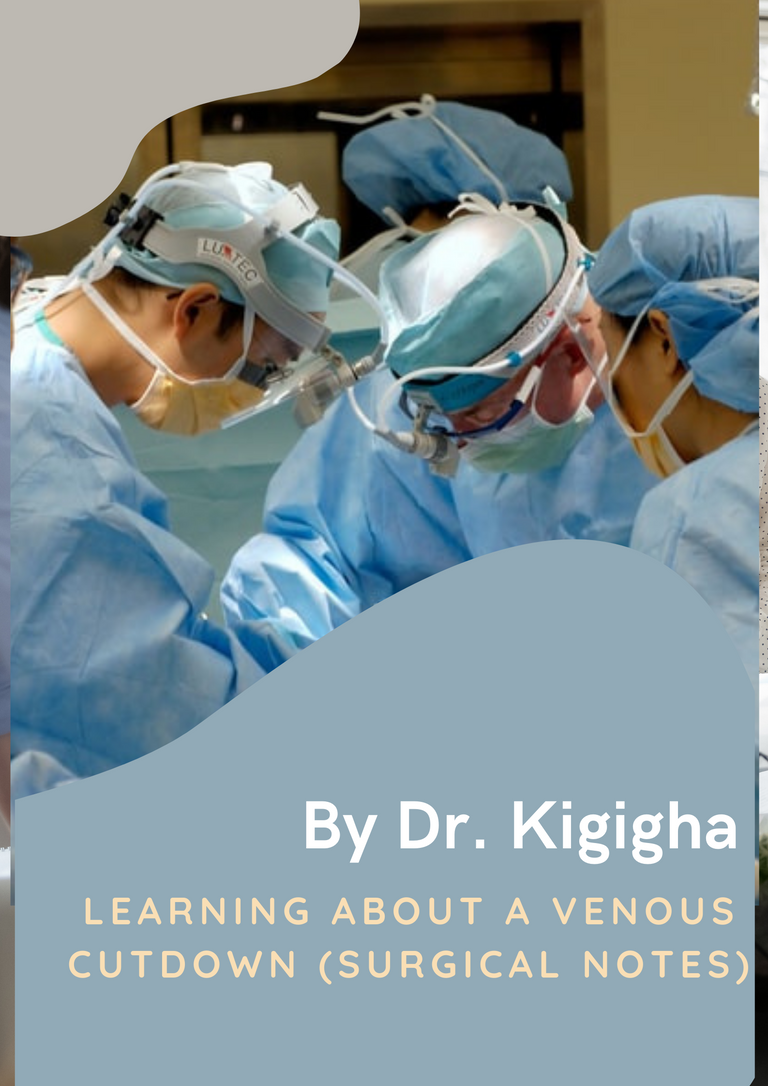Learning about a Venous Cutdown (Surgical notes)

Hi, I'm Ebingo Kigigha and I've been writing almost every Sunday evening/ Monday Morning for close to 3 months, ever since I wrote my last paper in medical school and got inducted into the medical profession.
I'm currently doing my internship program in a different institute from the one I trained . I trained at the University of Port Harcourt Teaching Hospital and I'm working as an intern for a year in the ancient city of Nnewi.
I am a part of the surgery team of Nnamdi Azikiwe University Teaching Hospital. During my stay in this unit (General surgery) I have had to answer to consults written by the Medical team and the Obstetrics and Gynecology team. Read here.
These other teams have been requesting one thing...A venous Cutdown...and that's what this post is about.
In this post, I'm going to take you through the process step by step as I learn more about it and teach you about it too.
What is a Venous Cutdown?
Before I dive into answering this question I'd like to have you get the ideas I had before reading about it. Since we are learning through my perspective, what went through my mind when I first heard about it was something involving cutting... So I already had the idea that a scalpel would be involved.
Fast forward to a few hours later when I was watching videos on how to do a venous cut down from youtube.
A venous cut down is a surgical procedure that involves cutting through skin and connective tissue to get to the veins to cannulate them.
Before you get to the veins you'll have to pass through layers of tissue that have protective functions. It comprises subcutaneous tissue, a tissue made up of cells fibrin fibers, and granules.
After the skin, the surgeon will cut structures such as a fibrous band that anchors the skin to the deeper fascia, collagen that attaches the skin to the dermis, and a small layer of fat (as the only areas in the body that totally have no fat are the eyelid, penis, pinna, and scrotum). Find out more here.
It is somewhat obsolete
The procedure has almost disappeared from medical practice which is why it was weird that I did not know much about it when it was mentioned by the consulting team.
It should not be much of a surprise because Nnamdi Azikiwe University Teaching Hospital is a very old medical center, so I guess the old practices have gone on in the center.
Some procedures that have replaced the venous cut down are procedures like Central Venous Catheterisation and Interosscius infusion.
I have actually seen Central Venous catheterization being done when I was a student in the Pediatric Department in the fifth year of my studies. We usually did it to measure Central venous Pressure and also to do exchange blood transfusions in babies that have severe hyperbilirubinemia.
In addition to procedures mentioned that have replaced this procedure, there is also the rectal method of giving drugs. There is a huge network of veins in the rectal mucosa that forms part of a system of veins known as the portocaval anastomosis.
See more here
Why are these procedures like this used?
These procedures are usually used when veins are difficult to cannulate or are near impossible to cannulate. This usually takes place when a person is in shock.
When a person is in shock the person's blood vessels fall flat because there is not enough blood to keep them open and therefore are difficult to cannulate or puncture and stay in.
It becomes necessary to cannulate a patient when blood vessels flatten like this because fluids might need to be given to raise the blood pressure of the patient. It is also important to cannulate them so that blood samples can be taken for studies in the laboratory to analyze the severity of the condition affecting the patient.
In the exchange blood transfusion, I described the patient...which a cute little baby is put in a position known as a crucifix...which is similar to the position Jesus Christ was crucified in and is laid on a platform to properly expose the abdomen and blood is drawn from the abdomen and replaced. The blood that is drawn from the abdomen usually contains a substance that is to be diluted and is replaced with whole blood.
How is the procedure done?
At the end of the day, I never saw one being done because my senior resident is chief when it comes to setting Intravenous lines. We'd get t the patient and he'd get a good light source.
One of the patients was a very old lady...I think she was in her 80's and she had a pacemaker (a device helping her heartbeat) on. He took her outside on her wheelchair and exposed her skin to a little bit of sun and in about 30 minutes we were done setting the IV line.
At this point, we still had about 2 other patients to do a venous cut down on, so I was ambitious that I would be seeing one being done but never did.
In order to do a venous Cutdown, there are some instruments the surgeon will need.
*The mask, so that the surgeon does not introduce any droplet or fluid from his or her respiratory tract into the open wound, Sterile water (or any other solution really) to prepare the vessel and make sure it is patent, a gown so that the blood from the patient does not infect the surgeon and also the surgeon's sweat can not get to the patient.
Gloves are worn too for similar reasons, to prevent infection to the patient and to the surgeon. Drapes are put over the surgical area so that the place to be cut open is made clear.
Gauze pads are used to clear the surgical area of blood, syringes with small needles (such as the 25-gauge needle). A scalpel with a 10 or 11 blade is used for cutting through the skin to get down to the blood vessel.
Hemostats are used to stop bleeding, scissors are used to cut and sometimes clear surgical areas. Once the blood vessel is secured an intravenous IV catheter will be placed in it. The suture material will be silk and nylon.
The area to be cut is cleaned and the drapes are put over it. Depending on the time available to the surgeon, anesthesia will be used to make sure the area has no sensation. Usually, Venous cut downs are done in emergency situations when the patient has lost a lot of blood and may die without it.
The greater saphenous vein located on the surface of the bone that makes the medial ankle is used in the surgery. A full-thickness skin incision, intended to go straight to the vein is made. Scissors can be carefully used to clear the surgical area until the vein is identifiable. The vein is about 2 cm in diameter and it is separated and raised from the structures next to it.
Once the vein has been exposed, it is tied at its distal end and the other end of it is cut open and dilated. A cannula is then inserted into the vein.
Complication of a Venous Cutdown
Cellulitis (Bacterial infection to the inner aspects of the skin) can occure as is common with nonsterile surgical procedures. Hematoma- a bleeding happening outside a blood vessel is also possible. Inflammation due to injury of a vein can also take place.
The procedure can lead to nerve injury especially when a vein such as the saphenous vein is used. This is the main drainage of the saphenous nerve and can lead to damage of the nerve.
References

!discovery 30
This post was shared and voted inside the discord by the curators team of discovery-it
Join our community! hive-193212
Discovery-it is also a Witness, vote for us here
Delegate to us for passive income. Check our 80% fee-back Program
Interesting. I have seen medical personnel complaining about not being able to locate the right vein in order to set lines. Never really know that venous cut down is a thing until now.
Yeah. Veins can be very difficult.
Especially in women and children
Thanks for your contribution to the STEMsocial community. Feel free to join us on discord to get to know the rest of us!
Please consider supporting our funding proposal, approving our witness (@stem.witness) or delegating to the @stemsocial account (for some ROI).
Please consider using the STEMsocial app app and including @stemsocial as a beneficiary to get a stronger support.